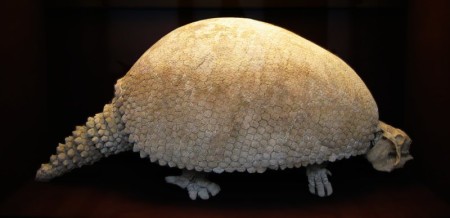
Two vets with an interest in palaeontology believe they have found the fossilised shell of a 10,000-year-old car-sized armadillo near the bank of a river in southern Uruguay.
Dr Geraldo Haran and colleague Feliciano Rosas found what they describe as the body armour of a Glyptodon while digging alongside the Santa Lucia River, which forms the border between Florida Department and Canelones Department.
A Glyptodon was part of the superorder of placental mammals known as Xenarthra. This clade of mammals also includes anteaters, tree sloths, armadillos, and extinct ground sloths and pampatheres. Its main food sources were plants and insects.
Glyptodonts (the family grouping) are believed to have grown to around the size of a VW Beetle. During the Pleistocene epoch, the creatures habituated Patagonia and farther north. They are the ancestors of present-day armadillos with similarly round, bony shells and squat limbs.
The weight of the animal whose remains were uncovered by the two vets could have been up to 1.5 tons, reportedly the largest of the extinct species to have ever been found in the South American country.
In an interview with Spanish international news agency EFE, Dr Haran said he and Rosas unearthed the armadillo’s shell accidentally. They were originally digging for “small fossils” when they encountered a “shell” that measured 1.77 metres (about 5 feet 9 inches) across.
“We went together to the bank of the Santa Lucia River. That morning, we began the search and found the shell … We’re very excited,” Haran said.
He added that when they made the discovery, they decided to inform local authorities and palaeontologists working at Montevideo’s Natural History Museum. The museum is set to conduct various studies on the shell to know more about the extinct species.
The Uruguayan army and the provincial government provided help during the transfer of the massive shell from the site of the dig to the laboratory, where palaeontologists will be examining it in detail.
Florida Governor Carlos Enciso told EFE he considers the 10,000-year-old armadillo discovery “of great importance,” adding that the state is offering its help to the researchers when it comes to logistical conditions so they can perform their studies on the fossil further.
“There is a history museum in the province … and it will have a room made available for this find,” Enciso stated.









